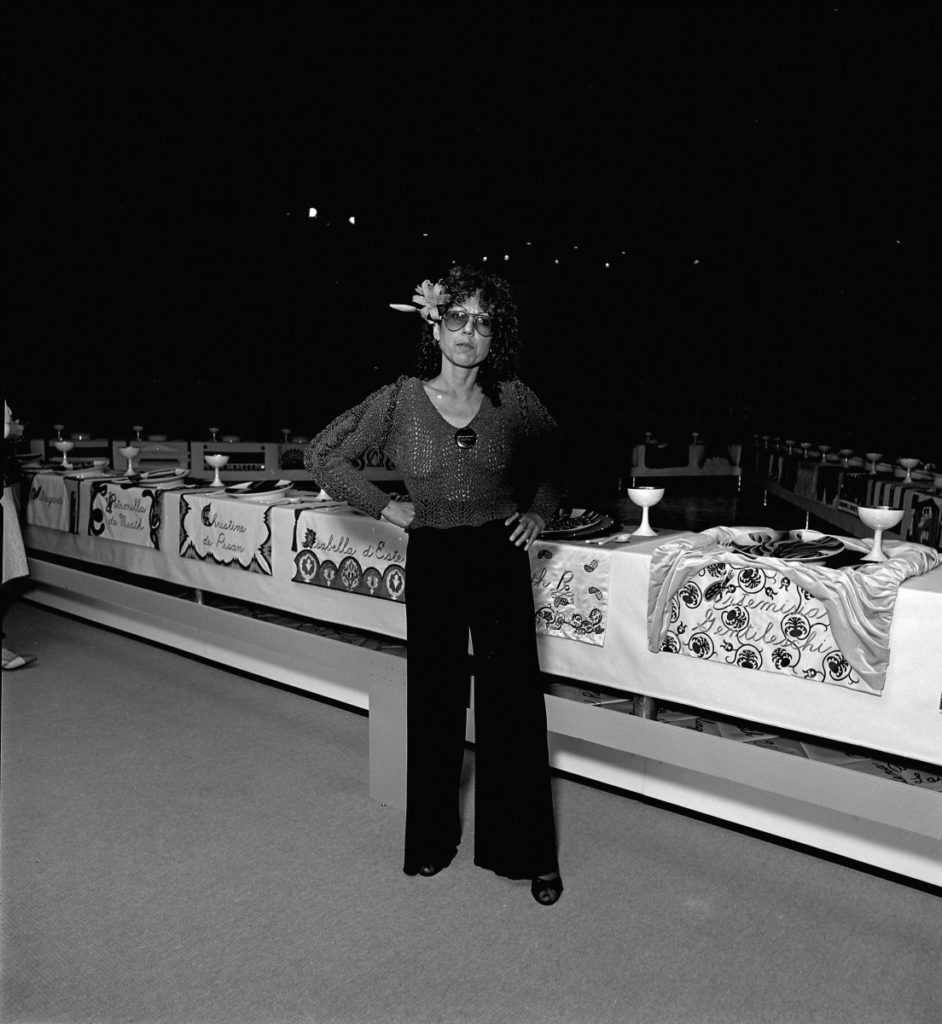Those of you on social media might recognize the How It Started / How It’s Going meme in which people post an image representing a naively optimistic version of themselves , followed by one where life has taken them in a different direction. We’re starting to highlight a similar experience for volunteers, showing what was featured at the AGO when they first started volunteering, then what they are doing now that the pandemic has changed the art scene. First up: Shelagh Barrington, Gallery Guide.

How It Started:
Viewing the AGO’s recently acquired (2018) six preparatory works, four ceramic test plates and 2 drawings made by Judy Chicago for the original installation of The Dinner Party brought back strong memories of my first volunteer experience. In 1982, I was among a group of young businesswomen and 50,000 other people who lined up to visit the AGO to view Judy Chicago’s The Dinner Party. This unusual work of art, now housed at the Brooklyn Museum of Art, attracted our young feminist selves and prompted feminist dialogue in the Toronto press. Later, that afternoon over drinks and enthusiastic talk about the show we learned about the dire plight of our Toronto’s women centre, The Pauline McGibbon Cultural Centre.
In the late 1970s, in response to the 1975 International Year of the Woman, the Pauline McGibbon Cultural Centre came into existence in an imposing two-storey red brick building at 86 Lombard that had originally housed the Toronto City Morgue. Unfortunately, the Centre very soon ran into financial trouble through overly ambitious plans to run a for profit centre and restaurant.
After a few meetings and much input and discussion, a newly formed group of young feminist volunteers resolved to save Toronto’s Women’s centre and sketched out a rough business case to keep the doors of the PMCC open.
A fun but often tense few years learning to run a not for profit business by the seat of our pants. We charged smaller than usual commissions for art sales of new and developing artists, assisted new playwrights launch their work, offered the centre for very reasonable fees for women’s events, put on music nights and gambling fundraisers. We worked with the federally funded Katimavik youth employment program and often we and our better halves and friends volunteered to staff the rental and fundraising nights. We were saved financially many times by the fact that we could put off paying the very hefty heating/cooling bills as the buildings furnace/ac also looked after the attached ambulance centre next door!
(In 1984 I got married there and I believe I can claim that we are the only couple married in what had been, Marty Shulman’s 2nd floor Coroner’s Court in Toronto’s old City Morgue!)
In 1985 our group of volunteers decided to close the Pauline McGibbon Cultural Centre as both for and not for profit institutions, around the city of Toronto were more efficiently handling the varied cultural needs of women. In 1996 I began my next volunteer experience with the AGO.
Read more: An interesting piece in the Toronto Star marking the 25th anniversary of the AGO’s Dinner Party exhibition.

How It’s Going:
Today because of COVID-19, many of us are visiting our favourite galleries, around the world virtually through internet connections. Here, in Toronto this past fall, together with a small group of friends I attended the Immersive Van Gogh Exhibit at the old Toronto Star office and publishing plant at 1 Yonge St. The immersive exhibition is on a roughly 40-minute loop so if it suits, you can enter at any point and remain as long as you like. There are social distancing circles on the floor, but you can move around and there are a few benches for seating and an elevated platform for a different perspective.
We practised social distancing and wore masks. After a timed entry we followed the floor directions to the tunnel-like entrance way. Several wall screens on either side highlighted the different periods of Van Gogh’s artistic life with accompanying paintings. Once we leisurely absorbed the facts, a blackout curtain was raised for us and we entered a large lowly lit hall. It was like watching Van Gogh paint the walls and floor with his beautiful scenes accompanied by a great soundtrack. Immersive Van Gogh is an entertainment experience but also a unique introduction to the art of Van Gogh. Art does not need to just hang on gallery walls!
Would you like to share your own reflections on what was happening at the AGO when you started and what you’re experiencing now? Contact Anne Fleming at [email protected]. Any length is fine, as are image-based submissions.